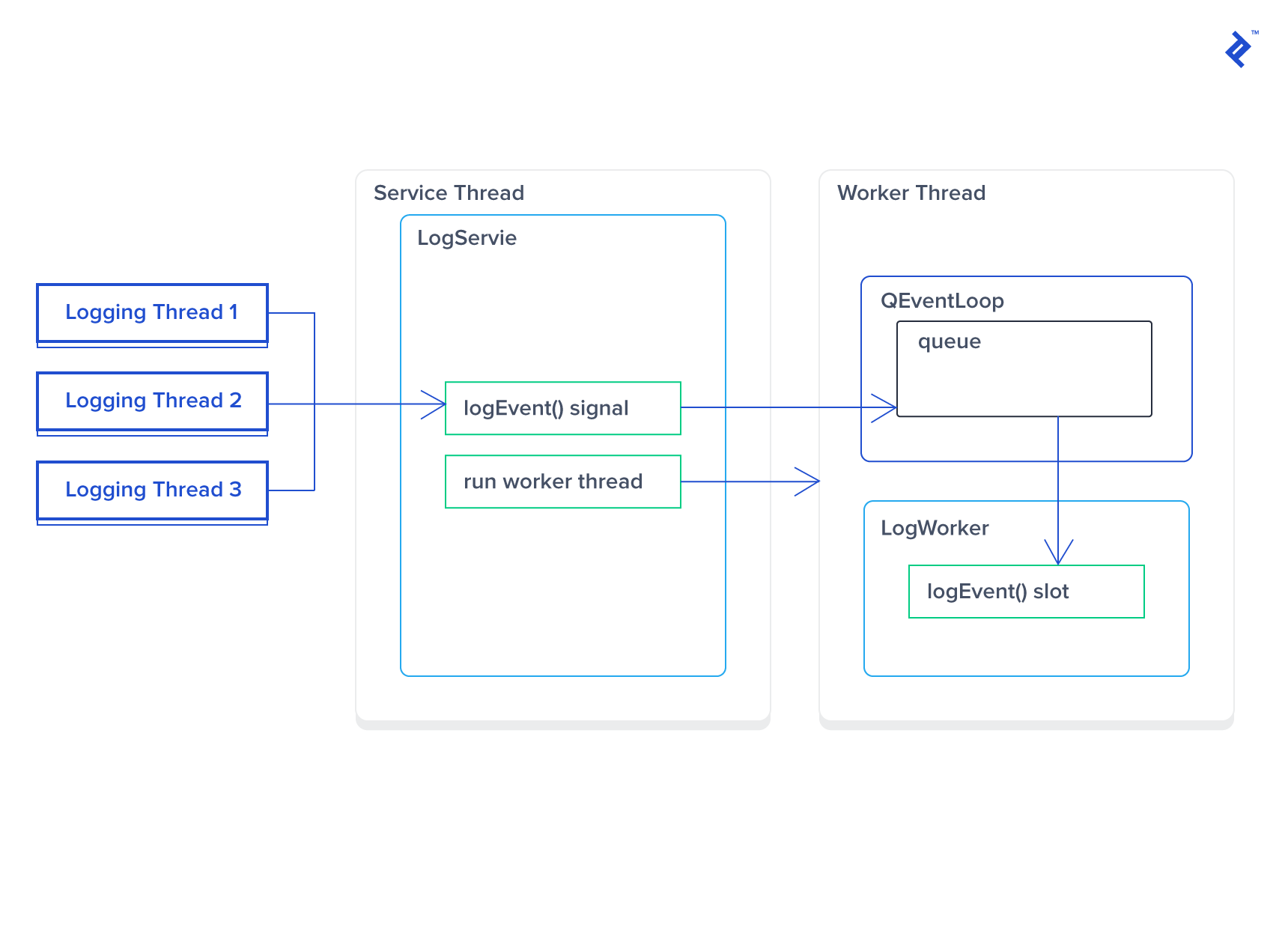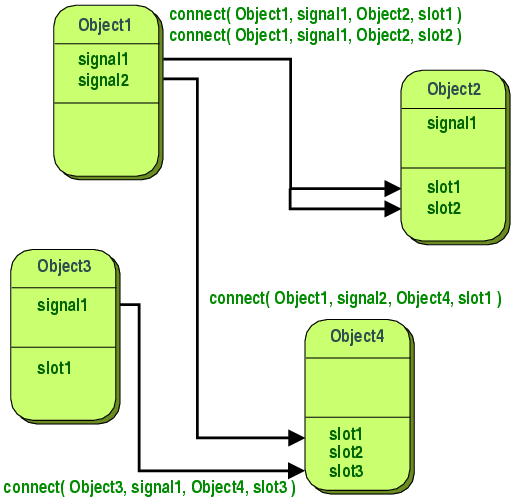I once debated over the circumstances during whichthreading would be preferable over forking. By the end of my researchand discussions with others, we had come to the conclusion thatthreads are ideal when you want access to some data between yourprocessing branches. But you have to be careful to avoid the pitfallsof non-thread-safe behavior.
Signals And Slots Across Threads Qts
Remember to keep everything as small and simple aspossible. Nobody wants to maintain your clever multithreading tricks,or your gigantic god-structures; least of all your future self. Qtprovides an easy to use write locker method that automatically unlocksat the end of its method. If you are concerned about the performancehit, you need to get away from your computer and revisit the design.Keep your locks small and fast.

Wrong:
Now there is a way to force your code execution to jump into a slot in another thread, that is by invoking a method: QMetaObject::invokeMethod( pointerToObject., 'functionName', Qt::QueuedConnection); The Basics. So let´s go over the signal/slot mechanism quickly. There are three actors in the system: signals, slots and connect. Signals and slots across threads work in a similar way. When we connect a signal to a slot, the fifth argument of QObject::connect is used to specify the connection type: a direct connection means that the slot is always invoked directly by the thread the signal is emitted from. Signals and Slots (The Unfortunate Wrong Way) It's worth noting that at first I thought signals and slots would be an excellent means of transferring data across threads. However, you will find that the timing of emitting a signal might not be what you expect, at least in a typical command line application. Important: Please read the Qt Code of Conduct. And it seems to be a multi-thread signal/slot connect issue. 1 Reply Last reply. Qt::AutoConnection: If the receiver lives in the thread that emits the signal, Qt::DirectConnection is used. Otherwise, Qt::QueuedConnection is used. The connection type is determined when the signal is emitted. Qt::DirectConnection: This slot is invoked immediately when the signal is emitted. The slot is executed in the signaling thread.
Lock -> long process -> mutate data -> unlock
Right:
Long process -> lock -> mutate data -> unlock
Best live blackjack websites. If you are looking at mutating a large data structure,which might take a long time to iterate and process, try to breakdown the problem: Copy out the necessary components to change and addthem back in. Since this isn't Haskell, copying the entire structurecan lock up your treads on its own. You need to break your problemdown into more manageable components. That means breaking down thedata structures into reasonable, logical modules as well as themethods.
LockerDeclaration
You will need some accessible memory set aside in yourworker class to use. Fist you will need to declare some memory thatthe lock will use. Then you will need a pointer to the location inmemory where you want to change the data. This data was initializedin the main thread, and the worker takes its address whenconstructed.
https://gist.github.com/erickveil/9d3688cccf099b51830eThe useLockToChange method will perform that quick lockand mutation we want.

LockingMethod
Again, this is where we want to keep it a simple andsmall as possible. Qt's write locker will automatically unlock whenthe calling method returns. I think that if you need to specificallylock and unlock a section of a larger method, then you need torefactor: You are trying to do too much with a single method.
https://gist.github.com/erickveil/9ea942047aa8740f7042Signalsand Slots (The Unfortunate Wrong Way)
It's worth noting that at first Ithought signals and slots would be an excellent means of transferringdata across threads. However, you will find that the timing ofemitting a signal might not be what you expect, at least in a typicalcommand line application.
https://gist.github.com/erickveil/7f5c28f35fe7cc2ef91a
Wrong:
Now there is a way to force your code execution to jump into a slot in another thread, that is by invoking a method: QMetaObject::invokeMethod( pointerToObject., 'functionName', Qt::QueuedConnection); The Basics. So let´s go over the signal/slot mechanism quickly. There are three actors in the system: signals, slots and connect. Signals and slots across threads work in a similar way. When we connect a signal to a slot, the fifth argument of QObject::connect is used to specify the connection type: a direct connection means that the slot is always invoked directly by the thread the signal is emitted from. Signals and Slots (The Unfortunate Wrong Way) It's worth noting that at first I thought signals and slots would be an excellent means of transferring data across threads. However, you will find that the timing of emitting a signal might not be what you expect, at least in a typical command line application. Important: Please read the Qt Code of Conduct. And it seems to be a multi-thread signal/slot connect issue. 1 Reply Last reply. Qt::AutoConnection: If the receiver lives in the thread that emits the signal, Qt::DirectConnection is used. Otherwise, Qt::QueuedConnection is used. The connection type is determined when the signal is emitted. Qt::DirectConnection: This slot is invoked immediately when the signal is emitted. The slot is executed in the signaling thread.
Lock -> long process -> mutate data -> unlock
Right:
Long process -> lock -> mutate data -> unlock
Best live blackjack websites. If you are looking at mutating a large data structure,which might take a long time to iterate and process, try to breakdown the problem: Copy out the necessary components to change and addthem back in. Since this isn't Haskell, copying the entire structurecan lock up your treads on its own. You need to break your problemdown into more manageable components. That means breaking down thedata structures into reasonable, logical modules as well as themethods.
LockerDeclaration
You will need some accessible memory set aside in yourworker class to use. Fist you will need to declare some memory thatthe lock will use. Then you will need a pointer to the location inmemory where you want to change the data. This data was initializedin the main thread, and the worker takes its address whenconstructed.
https://gist.github.com/erickveil/9d3688cccf099b51830eThe useLockToChange method will perform that quick lockand mutation we want.
LockingMethod
Again, this is where we want to keep it a simple andsmall as possible. Qt's write locker will automatically unlock whenthe calling method returns. I think that if you need to specificallylock and unlock a section of a larger method, then you need torefactor: You are trying to do too much with a single method.
https://gist.github.com/erickveil/9ea942047aa8740f7042Signalsand Slots (The Unfortunate Wrong Way)
It's worth noting that at first Ithought signals and slots would be an excellent means of transferringdata across threads. However, you will find that the timing ofemitting a signal might not be what you expect, at least in a typicalcommand line application.
https://gist.github.com/erickveil/7f5c28f35fe7cc2ef91aAdd the member variable to be changedon the MainClass in your main thread. Also define your slot here. Weare going to emit a matching signal, with a string passed as anargument from the worker thread back to here. We make the actualchange of the value from the slot on the main thread, so you wouldthink it would be safe to assume that there is no need to lock tomake the change.
Star Pisces is homeported in vibrant Hong Kong, celebrated for its inspiring museums, mega shopping malls and Avenue of the Stars. Cruise into the South China Sea and enjoy brilliant on-board dining, more shopping and some lively entertainment. Star cruise pisces casino. The Star Pisces offers one night cruises from Hong Kong to the South China Sea. Star Pisces Ship Profile & Stats. Cruise Line: Star Cruises. Casino: Yes; Star Pisces Dining Choices. Breakfast, dinner and supper are provided daily for free. Both indoor and outdoor pools are available. Board the Star Pisces by Star Cruises at Ocean Terminal, a 1-minute walk from Harbour City Shopping Mall. It is also within a 5-minute walk from Hong Kong Star Ferry Pier and Tsim Sha Tsui MRT Station. MS Star Pisces is a cruise ship, owned by Star Cruises. She does short cruises from Hong Kong. She was originally built as the cruiseferry MS Kalypso in 1990 at Masa-Yards Turku New Shipyard, Finland for Rederi AB Slite for use in Viking Line traffic. The ship was designed by Per Dockson. Star Pisces has a sister ship, Pearl Seaways.
Signals And Slots Across Threads Qtc
Running the application now will revealthat no matter where you emit the signal, the slot does not run untilthe emitting thread finishes. You will see the initial value for thisnew variable printed the same as it started, at the same time thealtered locked variable is printed. Only when the thread declares itis finished do we see the output from the slot method, announcing thedata change.
